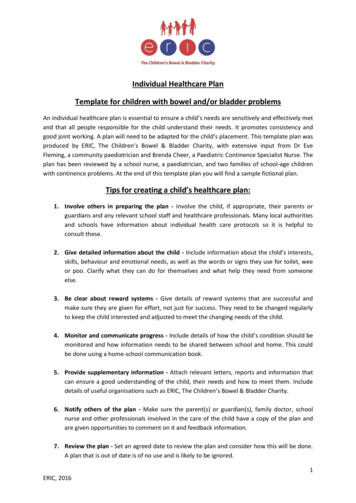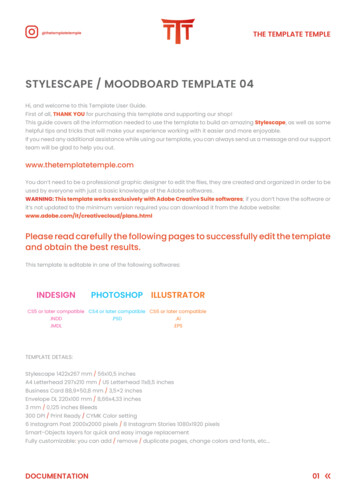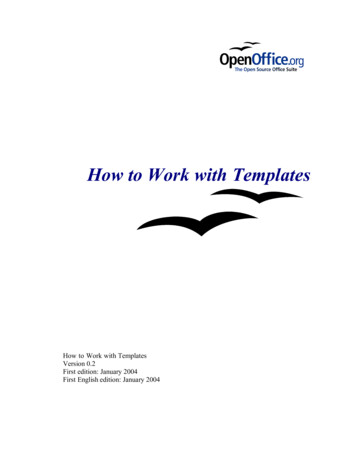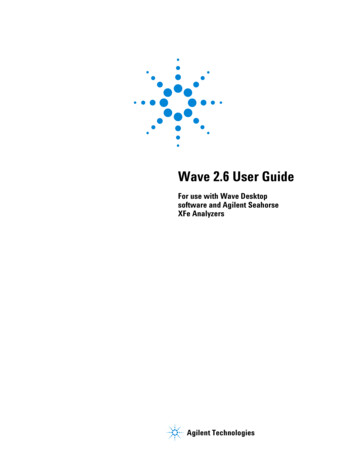
Transcription
Individual Healthcare PlanTemplate for children with bowel and/or bladder problemsAn individual healthcare plan is essential to ensure a child’s needs are sensitively and effectively metand that all people responsible for the child understand their needs. It promotes consistency andgood joint working. A plan will need to be adapted for the child’s placement. This template plan wasproduced by ERIC, The Children’s Bowel & Bladder Charity, with extensive input from Dr EveFleming, a community paediatrician and Brenda Cheer, a Paediatric Continence Specialist Nurse. Theplan has been reviewed by a school nurse, a paediatrician, and two families of school-age childrenwith continence problems. At the end of this template plan you will find a sample fictional plan.Tips for creating a child’s healthcare plan:1. Involve others in preparing the plan - Involve the child, if appropriate, their parents orguardians and any relevant school staff and healthcare professionals. Many local authoritiesand schools have information about individual health care protocols so it is helpful toconsult these.2. Give detailed information about the child - Include information about the child’s interests,skills, behaviour and emotional needs, as well as the words or signs they use for toilet, weeor poo. Clarify what they can do for themselves and what help they need from someoneelse.3. Be clear about reward systems - Give details of reward systems that are successful andmake sure they are given for effort, not just for success. They need to be changed regularlyto keep the child interested and adjusted to meet the changing needs of the child.4. Monitor and communicate progress - Include details of how the child’s condition should bemonitored and how information needs to be shared between school and home. This couldbe done using a home-school communication book.5. Provide supplementary information - Attach relevant letters, reports and information thatcan ensure a good understanding of the child, their needs and how to meet them. Includedetails of useful organisations such as ERIC, The Children’s Bowel & Bladder Charity.6. Notify others of the plan - Make sure the parent(s) or guardian(s), family doctor, schoolnurse and other professionals involved in the care of the child have a copy of the plan andare given opportunities to comment on it and feedback information.7. Review the plan - Set an agreed date to review the plan and consider how this will be done.A plan that is out of date is of no use and is likely to be ignored.1ERIC, 2016
My Health Care PlanDate of plan:Planned review date:(The plan should be reviewed annually or more frequently if the child’s situation changes)Name of person completing plan and their role:Child’s/young person’s detailsChild’s nameDate of BirthYear groupHome addressSchool nameSchool addressFamily contact informationNameRelationship to childTelephone numberHomeWorkMobileEmailAddress if different to childNameRelationship to childTelephone numberHomeWorkMobileEmailAddress if different to childSiblings’ namesHealth contactsSpecialist nurseConsultantGeneral PractitionerSchool nurseEducation contactsClass teacherSpecial Needs coordinator (if relevant)Other support staff in school2ERIC, 2016
Description of childGive brief details of child’s interests, behaviour and relevant conditions, e.g. speech and language,mobility (more detailed information about the child may be available).Description of continence problemMedicationName of medication. If any medication needs to be taken in school refer to the school’s medicationdocumentation.Management and routine (e.g. details of drinking and toileting routines and goals to be achieved)Hygiene and help required for personal careArrangements for school visits/trips etc3ERIC, 2016
Use and disposal of continence productsArrangements for soiled clothes and underwearReward systemsPossible difficulties that could arise and actions to be takenGoals for continence managementGoals for the child4ERIC, 2016
Training delivered byI . . . (insert name and role) confirm that I trained . . . (insert name of stafftrained) to deliver the care detailed above on . (insert date of training).TrainingdeliveredFirst nameRoleSignedLast nameDateParent or guardian consent for implementation of above care planI . (insert name), . (insert relationship to child) of . (insertchild’s name) agree to (insert carer name) to care for my child asdetailed in the above plan.First nameRelationship to childSignedLast nameDateStaff/carer agreement to deliver care (primary member of staff)I (insert name and role) agree to deliver care as detailed above following training whichI have received from . (insert name of person who delivered training).First nameRoleSignedLast nameDateStaff/carer agreement to deliver care (additional person trained to deliver care)I (insert name and role) agree to deliver the care detailed above following trainingwhich I have received from . (insert name of person who delivered training).First nameRoleSignedLast nameDateStaff/carer agreement to deliver care (additional person trained to deliver care)I (insert name and role) agree to deliver the care detailed above following trainingwhich I have received from . (insert name of person who delivered training).First nameRoleSignedLast nameDate5ERIC, 2016
Reassessment of carerThe carer’s training and ability to deliver care should be reviewed at least every six months.Date of assessmentFirst name of assessorSigned by assessorFirst name of carerSigned by carerNext assessment dueLast name of assessorDateLast name of carerDateAdditional information attached (list additional documentation that complements the plan)Useful contactsERIC, The Children’s Bowel and Bladder Charity – provides information, support, training andresources to manage bowel and bladder difficulties. ERIC’s Guide to Managing Children’s ContinenceProblems in Schools contains information about childhood continence problems, how to create acontinence policy and individual health care plans, how to promote bladder and bowel health inschools and ways to support children with special needs who have continence issues. Download itfrom www.eric.org.ukPromoCon – Part of the charity ‘Disabled Living’, providing advice and support to adults and childrenwith continence difficulties and complex needs. www.disabledliving.co.uk/PromoCon6ERIC, 2016
Sample plan (fictional)Child’s/young person’s detailsChild’s nameDate of BirthYear GroupHome addressSchool nameSchool addressSam Parker12th September 2009Year 39 Tree Lane, Norwich, N01 1LRAll Saints Primary3 School Lane, Norwich, N01 3PTFamily contact informationNameRelationship to childTelephone numberHomeWorkMobileEmailAddress if different to childNameRelationship to childTelephone numberHomeWorkMobileEmailAddress if different to childSiblings’ namesSally ParkerMother01322 35674801322 35876707429612677Sally.parker@btinternet.comJo ParkerFather01322 35674801322 35698807496675563Jo.parker@btinternet.comJoelle Parker, Jamie ParkerHealth contactsSpecialist nurseConsultantGeneral PractitionerSchool nurseDr Peter KellyDr Andrew BillingsJean TaylorEducation contactsClass teacherSpecial Needs coordinator (if relevant)Other support staff in schoolMrs Linda SamsonDescription of childSam is a lively active little boy who loves playing outside. He is interested in nature, especially frogsand toads. He is chatty, but it is sometimes difficult to understand all he says, as his speech is notalways clear especially if he is excited. He loves being read to. He likes school, but sometimes getsupset if he is tired. His best friend is Jack and they like playing with Lego.7ERIC, 2016
Description of continence problemSam suffers from constipation and is on regular treatment for this. It is thought that there is noabnormality in his bowel. He has frequent wetting and soiling accidents in the day and wets thebed most nights. Sam does not appear to know when he needs to go to the toilet. He does go andtry if he is reminded. He has learned to sit on the toilet. Constipation makes him irritable. Sam wasteased at school last term about being smelly and became very upset and reluctant to go to school.MedicationSam takes 2-3 movicol sachets each morning. He does not always like these, but will sometimestake them with a straw, or mixed with diluted lime juice. The dose of medicine is adjusted to makesure he opens his bowels, and his mother has been given advice about this. (She needs to havedetails about Sam’s bowel pattern to help decide how much medication he needs. See Sam’s chartand information about his medication.Management and routine (e.g. details of drinking and toileting routines) Sam to go to the toilet 3 times a day. He must be taken to toilet by [insert name ofsupervisor] after morning play and lunch and mid-afternoon. If he soils significantly inbetween these times he needs help to attend to personal hygiene and change his pad and ifnecessary his clothes. Sam should be praised for going to the toilet to try to wee or poo.Sam to consume the bottle his parents send in with him during the school day (at least500mls). He must be prompted to drink before break times by [insert name of supervisor].Information to be recorded in home school communication book and sent home with Samevery day.Hygiene and help required for personal care.He can dress and undress himself and wash his hands. Sam is able to change wet pads and cleanhimself with a wet wipe if he is slightly soiled, but he may not always notice when he needs tochange and may need prompting. If he has a large amount of soiling he will need help from an adultto clean himself and may need access to appropriate washing facilities.Arrangements for school visits/trips etcSam can go on school trips but he must have spare clothes, pads and wet wipes. His parents willprovide this. He should be reminded to drink and go to the toilet when on the trip. Staff should ensurehe has access to a toilet, e.g. if on a school coach Sam should sit close to the toilet.Use and disposal of continence productsSam wears small continence pads. He has special protective swim trunks for swimming. Pads can bedisposed of in the normal waste.Arrangements for soiled clothes and underwearSoiled underwear can be put in a waterproof bag, and sent home for washing. Sometimes otheritems of clothes may be soiled and need to be changed. His parents have agreed to send in spare8ERIC, 2016
clothing and wet wipes and pads in his rucksack. Sam should have easy access to this.Reward systemsGive Sam a chocolate button when he tries to go to the toilet when he is reminded. Give him apicture of a frog if he does a poo in the toilet. The rewards may need to be reviewed with Sam’sparents if he is getting bored and needs a change.Possible difficulties that could arise and actions to be takenWhen Sam is constipated he suffers from overflow soiling. This can sometimes have the appearanceof diarrhoea. Sam does not need to be sent home as this is NOT infectious. He should only be senthome if he is unwell e.g. he is vomiting as well as passing loose stools.Goals for continence management To establish a regular toileting programme – by the end of the first term Sam goes to thetoilet at similar times each day.To record events and progress in the home school communication book (e.g. when Sam hasa wetting accident or manages to change his pad by himself).To reduce the frequency and amount of soiling and wetting (measurable by reviewing thehome school communication book).Goals for the child Sam to gradually increase the amount he drinks each day aiming to be able to finish his500mls drink that his parents send with him in a day by half-term.Sam to be able to change his pad himself by the end of term.Additional information attachedLetter from Sam’s consultant.Speech therapy reportInformation about Movicol from Norgine the manufacturer9ERIC, 2016
Fleming, a community paediatrician and Brenda Cheer, a Paediatric Continence Specialist Nurse. The plan has been reviewed by a school nurse, a paediatrician, and two families of school-age children with continence problems. At the end of this template plan you will find a sample fictional plan. Tips for creating a child's healthcare plan: 1.










